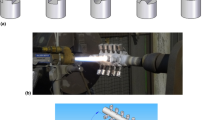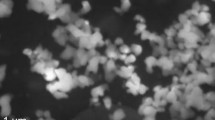Abstract
Pure aluminum coatings deposited by a high velocity oxyfuel (HVOF) process have been produced and studied. A simple design-of-experiment (DOE) was used to assess the effect of two deposition parameters, the spray distance and oxygen-to-fuel ratio, on relevant coating properties. Porosity, surface roughness, and micro-hardness of the coatings were measured as responses to changes in the DOE parameters. The results indicated that these three properties of the aluminum coatings were normally insensitive to spray distance. Oxygen-to-fuel ratio, by flow, did appear to affect the porosity level of the coatings. Some post-coat processing of the aluminum coatings and minimization of nozzle loading are discussed.
Similar content being viewed by others
References
W.H. Thomason: “Cathodic Protection of Submerged Steel With Thermal-Sprayed Aluminum Coatings,” Materials Performance, 1984, 24(3), pp. 20–28.
F. Génin, J. Menapace, A. Burnham, and I. Stowers: “Damage Thresholds of Painted and Coated Steel, and Other Metals at 1064nm (10-ns),” NIF-000-97-0004472, Lawrence Livermore National Laboratory, Livermore, CA, 1998.
M.J. Thomas: “Laser Damage Measurement of Flame Sprayed Aluminum Samples,” Report 011100LL, Spica Technologies, Nashua, NH, 2000.
J. Pryatel, D. Ravizza, and I.F. Stowers: “Surface Cleanliness Validation by Swiping of NIF Components,” LLNL MEL98-012-OD (also NIF5002426), Lawrence Livermore National Laboratory, Livermore, CA, 2001.
R.L. Apps: “The Influence of Surface Preparation on the Bond Strength of Flame-Sprayed Aluminum Coatings on Mild Steel,” J. Vac. Sci. Technol., 1974, 11(4), pp. 741–46.
H. Leidheiser, Jr., S. Music, A. Vértes, H. Herman, and R.A. Zatorski: “Metal/Flame-Sprayed-Aluminum Interface as Studied by Emission Mössbauer Spectroscopy,” J. Electrochem. Soc., 1984, 131(6), pp. 1348–49.
T.Z. Kattamis, M. Chen, R. Huie, J. Kelly, C. Fountzoulas, and M. Levy: “Microstructure, Adhesion, and Tribological Properties of Conventional Plasma-Sprayed Coatings on Steel Substrates,” J. Adhesion Sci. Technol., 1995, 9(7), pp. 907–21.
R. Chow, T.A. Decker, R.V. Gansert, and D. Gansert: “Characterization of Thermal Sprayed Aluminum and Stainless Steel Coatings for Clean Laser Enclosers,” ASM Materials Solutions Conference and Exposition 2000, Thermal Spray, St. Louis, MO, 9–12 Oct 2000.
Author information
Authors and Affiliations
Rights and permissions
About this article
Cite this article
Chow, R., Decker, T.A., Gansert, R.V. et al. Properties of aluminum deposited by a HVOF process. J Therm Spray Tech 12, 208–213 (2003). https://doi.org/10.1361/105996303770348311
Received:
Revised:
Issue Date:
DOI: https://doi.org/10.1361/105996303770348311




